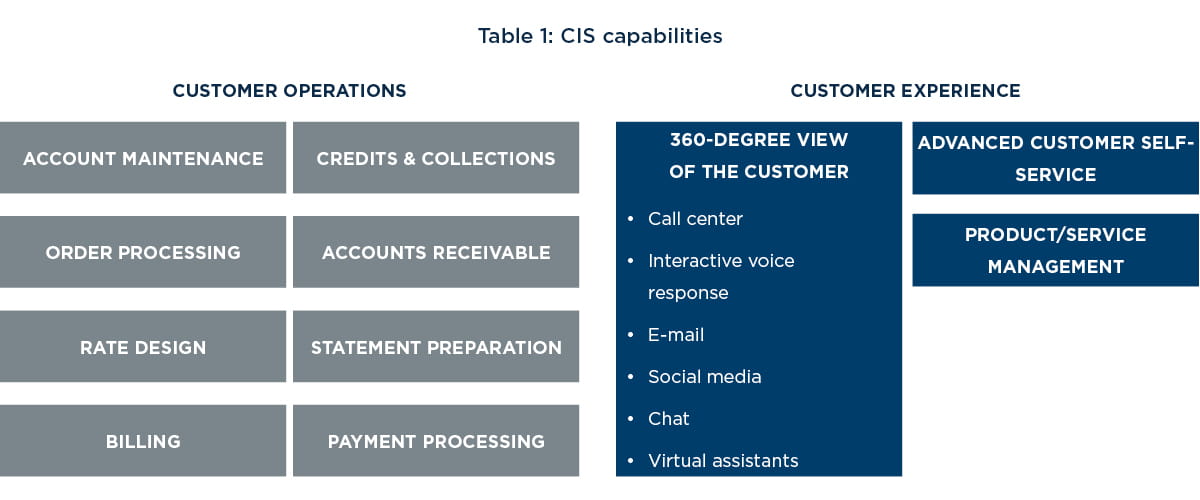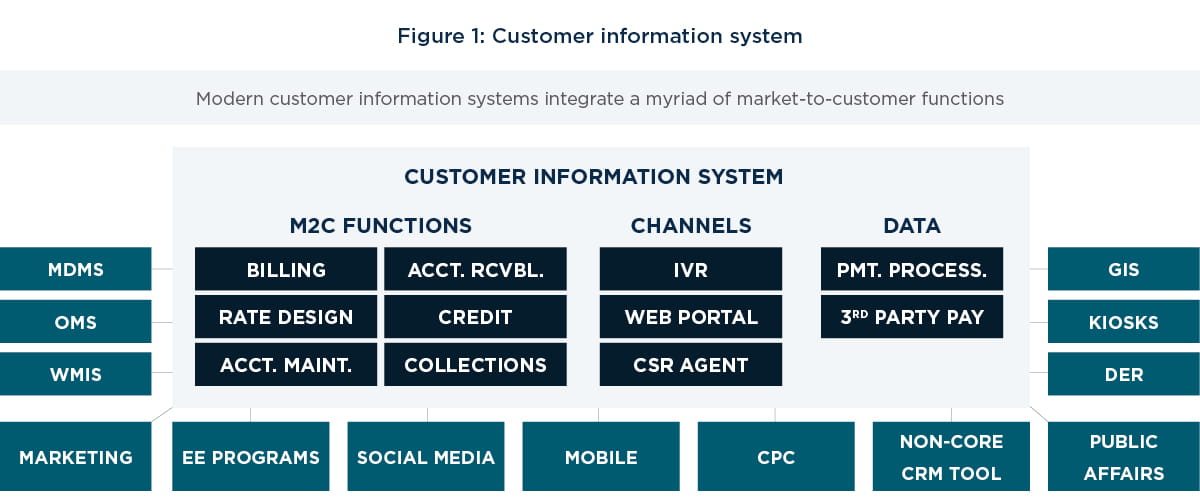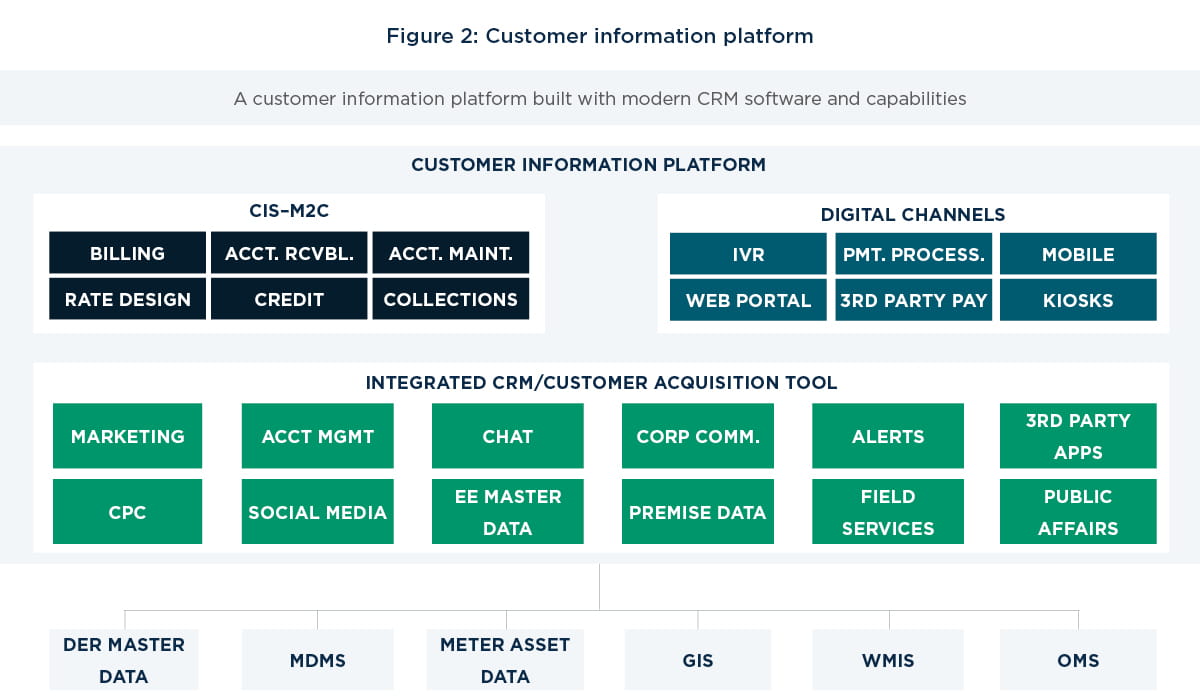
October 2018 | Point of View
Customer platforms for utilities: Choosing an 'evolution' over a 'big bang'
Customer platforms for utilities: Choosing an 'evolution' over a 'big bang'
Introduction
Growing utility and industry complexities and shifting customer expectations are placing tremendous pressure on utilities and challenging technology and systems that underpin operations. Many utilities have dated and aged customer information systems (CIS) lacking robust customer relationship management functionality. Furthermore, existing CIS platforms are not easily integrated with modern digital operating platforms. This is making it difficult for many utilities to advance critical customer initiatives, options, and rate structures that many customers and regulators are increasingly demanding.
Even under the best of circumstances, the replacement of a utility CIS is risky, time-consuming, and costly. These projects are difficult to implement and operationalize due to the vast number of business processes that CISs handle, the criticality of systems to core operations, and complex integrations required with nearly all other core utility applications.
We conclude that an alternative approach exists that would allow a utility to centralize and modernize customer engagement activities more quickly and with less risk through the deployment of a front-end customer relationship management (CRM) system that integrates with CIS and other information systems. This approach is referred to as the Customer Information Platform (CIP).
The journey toward building and running a safe, reliable, sustainable, responsive, and affordable utility is fraught with considerable complexity. Utilities are faced with multiple transformative initiatives. These include modernizing operations, responding to evolving regulatory mandates, and creating new business models focused on improved energy efficiency, load management, and distributed energy resources integration. All of this occurs while trying to improve relationships and interactions with customers.
Many utilities continue to run legacy CISs, which provide the backbone for market-to-customer activities such as billing and account maintenance. However, many of these legacy CISs lack the:
- Capacity for intelligently using data generated by advanced metering infrastructure (AMI)
- Flexibility to address complex electric market structures and billing requirements such as innovative rates and complex billing, load aggregation, and retail market enablement
- Native integration capabilities needed to capitalize on innovations around distributed energy resources for electric utilities, self-service, and mobile platforms favored by savvy consumers.
The CIS is to ‘big bang’ as CIP is to evolution
A key challenge for today’s utilities is how to update CISs to enable modern business and customer service models while remaining flexible enough to adapt to evolving future needs. In our view, utilities have two options, a traditional or innovative solution.
1. Implement a traditional customer information system
One route for upgrading market-to-consumer capabilities is to implement a next-generation CIS. Today’s software vendors offer solutions that are more flexible than legacy applications, with capabilities for addressing a myriad of utility billing and customer engagement requirements. Modern CISs from the top software vendors provide functionality for handling both traditional customer operations activities as well as sophisticated customer experience (CX) capabilities. The table below captures some of the most relevant functions across these two capabilities.
While there are many benefits to implementing a new CIS, these systems are extremely difficult and costly to implement. Since CISs are one of the core information systems at the heart of a utility, a “big bang” replacement, even if well run, tremendous risk exists in the form of needed technological and change management implications across many parts of the utility. The over-customization of legacy CISs also adds significant technical complexity to these replacement efforts. Ensuring that current state capabilities, integrations, and customizations are fully understood and translated, or reconciled into future-state requirements and needs, is a crucial and complex initial step that is often underestimated.
CIS transformations require time and resources, typically lasting more than a year and costing millions of dollars for small to mid-sized utilities. The largest programs will typically run three years or more and cost hundreds of millions of dollars. Since this is a sizeable undertaking, the landscape is littered with failed or underperforming CIS replacements that can have a wide range of negative and long-lasting consequences.
2. Progressively implement a CIP
We believe a CIP approach provides a compelling alternative to addressing the growing complexity at the intersection of technology and customer- centric business models. Figure 3 illustrates the CIP approach through the deployment of a front- end CRM system that integrates with CIS and other information systems.
Modern CRM platforms have extensive, built-in marketing, communication, field service, and other customer capabilities. A comprehensive view of customer activity is essential for driving profitable growth, making certain resource decisions, and shaping the customer experience. CRM platforms are extremely flexible and have well-established capabilities for integrating with other utility applications that produce and use data related to customer activities. Such activities include, work orders, outage information, distributed energy resources, energy efficiency and load management programs, marketing and community activities, and customer communication preferences.
In response to the growing demand for more improvements and expanded functionality to the customer experience, traditional CIS software providers are building more advanced capabilities in these areas. These capabilities and new modules are relatively immature in the context of traditional CIS capabilities. This is a positive step towards providing a more customer-centric viewpoint, but the track record and capabilities of these traditional software providers in delivering true customer relationship management is unproven.
CRM platforms are customer-centric by design and their use can accelerate a utility’s mission to improve the overall customer experience. The functionality of modern CRM applications has evolved to meet engagement requirements of customers across a variety of industries. As utilities begin to see users of their services as customers rather than ratepayers, the robust, cross-industry functionality typical for CRM can be very valuable to utilities looking to engage with modern consumers in a manner they expect and demand.
From consideration of the two approaches outlined, we offer the following perspective.
A CIP approach can ease the transition to a transformed CIS by allowing the utility to break the transformation into a series of smaller iterations. A CIP architecture allows a utility to move customer activities to the CRM progressively through a series of much smaller, discrete projects. Many utilities, such as ComEd and Indianapolis Power and Light, have already begun to move in this direction by utilizing a CRM system to handle the management of high-value customers, most notably commercial and industrial customers. These utilities can further capitalize on their efforts by formalizing a CIP approach to be used for the long-term customer transformation.
A CIP can accelerate time to value. The real value in a CRM-based customer information platform is its ability to accelerate analysis and sharing of customer data across internal operations and data repositories. A utility can move forward with a dynamic set of customer activities that run on a modern platform and grow in value as the individual elements evolve, rather than waiting for completion of a years-long CIS replacement. In turn, the utility can focus more time and attention on staff development and training for individual applications that are critical to its future.
For all its benefits, a CIP architecture must be carefully considered and constructed to ensure forward compatibility with CISs of the future. While CISs of the past were lacking in their ability to manage sophisticated customer interactions (many such interactions did not exist a few years ago), newer versions of CISs have increasingly begun to incorporate such functionality into their base software. Additionally, CIS software vendors have altered their system designs to allow for native integration to their own CRM/CX products. In the future, it is likely that the customer engagement functionality in modern CIS architectures will be handled almost exclusively through CRM/CX type modules integrated with a backend.
Conclusion
Utilities across the country are recognizing the need to take a transformative approach to improving the customer experience. Implementing a modern CRM prior to a CIS replacement or upgrade can provide much needed functionality and benefits in a relatively short period of time. The decision then becomes whether to leverage traditional CIS software provider’s ‘CRM’ modules and capabilities or choose best-of-breed. While both options can work, integrating a proven best-of-breed front-end CRM solution within the context of a modern customer information platform can provide unique value and benefits to the customer experience and employee engagement. This option requires “future-proofing” of the design and integration to ensure compatibility when the underlying legacy CIS is replaced. Careful consideration must be given to understanding the traditional CIS system of record and how any alterations of this construct will impact future system upgrades and replacements.
With either approach, utilities must position each of their technology investments to take advantage of the tremendous opportunity to improve the customer experience, streamline internal operations, and enable a flexible platform for modern utility operations that can more easily scale.





